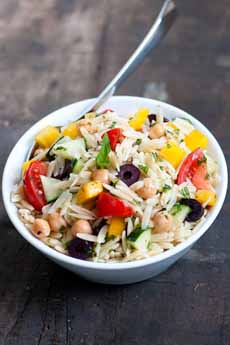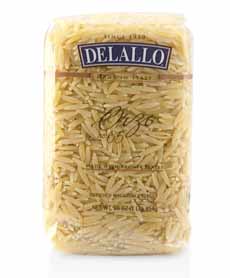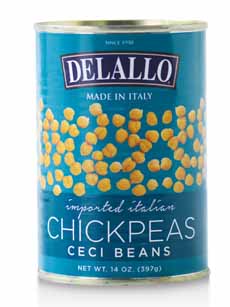Make A Side Salad With Leftover Orzo, Rice, Or Other Grain: The Recipe, Plus What Is White Balsamic Vinegar
|
are available from DeLallo.
|
Here’s a tasty idea from DeLallo to turn leftover orzo or grains into something much more appealing. The producer of premium packaged foods adds color and flavor, including tart Kalamata olives and a golden/white balsamic vinegar-based (see below) vinaigrette. If you’re using darker grains, you can use a regular balsamic. With a Greek flair, this combination of crunchy, sweet, and tart will make you want a larger portion than a side. Orzo is a shape of pasta that is extruded (shaped through metal plates) to look like grains of rice, about 1/3-inch long (photos #1 and #2). It is made of the same durum wheat as other Italian pasta. The durum is milled into semolina flour and then blended with spring water. The dough is then extruded and allowed to dry. Orzo is frequently used as a substitute for rice and can be used instead of, or combined with, rice to make pilafs and risottos. It is also used like rice or barley in soups, salads, and sides. See more types of pasta in our Pasta Glossary. Ingredients For 6-8 Sides 1. MAKE the dressing: Combine the vinegar, lemon juice, salt and pepper in a mixing bowl. Whisk together to incorporate. Introduce the oil in a steady stream while whisking. Set aside. 2. COMBINE the chickpeas, olives, bell pepper, tomatoes, cucumbers, and fresh herbs in a large serving bowl. Toss with the orzo or grain. 3. ADD the dressing and mix well to coat. Season with salt and pepper to taste. Serve at room temperature or lightly chilled. Golden or white balsamic vinegar is made in the balsamic style, with Trebbiano, a white grape, but without the dark grapes that contribute to the dark color of regular balsamic. It is blended with white wine vinegar. |
|
|
It was created in the same area of Italy (Modena) as traditional balsamic vinegar, developed to have a lighter color for use in light-colored sauces and vinaigrettes. In addition to vinaigrettes and sauces, use it to deglaze a pan and to dress roasted vegetables. Although it was introduced as white balsamic, it has a golden color. More recently, producers have been calling it golden balsamic: It’s the same thing. White/golden balsamic vinegar has a sweet-and-tart flavor profile like the conventional product, but it tends to be sweeter than conventional balsamic. As with dark balsamic, the grape must (the freshly-crushed grape juice that contains the skins, seeds, and stems of the fruit) is simmered, but avoids the caramelization that turns the must dark. The result is also aged for less time, in oak or stainless steel barrels. And as with traditional balsamics, there are all levels of quality and price, and “factory made” balsamics that are white vinegar doctored to look and taste like an authentically-produced balsamic. Here’s more about balsamic vinegar. CHECK OUT WHAT’S HAPPENING ON OUR HOME PAGE, THENIBBLE.COM. |
||






